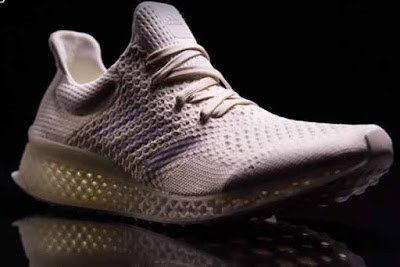Flexible Skins
Mesostructured Cellular Materials: 3D printed structures with the ability to deform and deflect in multiple directions as a result of their structural and geometric arrangement.
 |
| Mesostructured cellular sheet by Andreas Bastian On Thingiverse and his blog site |
These examples by Andreas Bastian, with other examples of double curve geometries below:
 |
| Andrea's other experiments include cellular structural geometries with 3D printing, post-formed over double curve geometries. These also offer an insight in to how double curve skins could evolve. |
 |
| Flexible materials developed by Students at Delft University. |
Stereolithographic fabrics: There are a variety of examples of stereolithographic fabrics produced through 3D printing.
 |
| 3D printed fabric developed for clothing by Richard Beckett |
Chainmail: An old invention made a lot simpler to produce with 3D printing. Geometric variations and additions to the units such as scales or feathers add to the possibilities of the material.
 |
| Chainmail by Kacie Hultgren. Square geometry used. |
 |
| Scale mail armour by Tom West. Scales could offer some weather resistance in a building application. Closest I've seen to replicating shark skin with flexible double curved geometries. |
Hexchain: A variation on the above using tessellating shapes with mechanical flexibility to adapt to double curve surfaces.
 |
| Hex Chain from Jay Jeon. A variation on scale mail. |
Flex Mesh: A kit of parts with mechanical flexibility between the components to allow movement and tolerance in three dimensions.
 |
| Flex Mesh uses flexible components with different geometries to achieve flexible 3D surfaces |
Fashion
3D printing is leading the way in fashion with developments to produce materials with mechanical flexibility to replicate fabrics.
 |
| 3D printed fabrics by Iris van Herpen. |
 |
| Flexible fabrics exhibited at the NYC 3D Print Show. |
 |
| Mechanically jointed geometric structures to create a flexible fabric by Kinematics |
 |
| Kinematics Petal fabric |
Footwear
3D printed trainers are on their way from Nike and Adidas, developed with 3D printing because of the potentially superior support and mechanical flexibility which this manufacturing method might offer.
Accessories
3D printed clutch using rectilinear chain mail shown above.
3D printing is drawing a lot of interest in architecture and building design, but that doesn't mean that building types need to be the same rigid structures or that site processes and prefabrication methods need to follow established patterns. It is useful to look beyond the building industry, into other areas of design and manufacture to see what neat ideas are with developing an a different scale. Maybe one day buildings might be flexible with the ablity to move and transform as Ron Herron imagined.
 |
| 3D printer trainers coming from Nike and Adidas |
Accessories
3D printed clutch using rectilinear chain mail shown above.
 |
| Clutch by Kacie Hultrgen |
3D printing is drawing a lot of interest in architecture and building design, but that doesn't mean that building types need to be the same rigid structures or that site processes and prefabrication methods need to follow established patterns. It is useful to look beyond the building industry, into other areas of design and manufacture to see what neat ideas are with developing an a different scale. Maybe one day buildings might be flexible with the ablity to move and transform as Ron Herron imagined.
